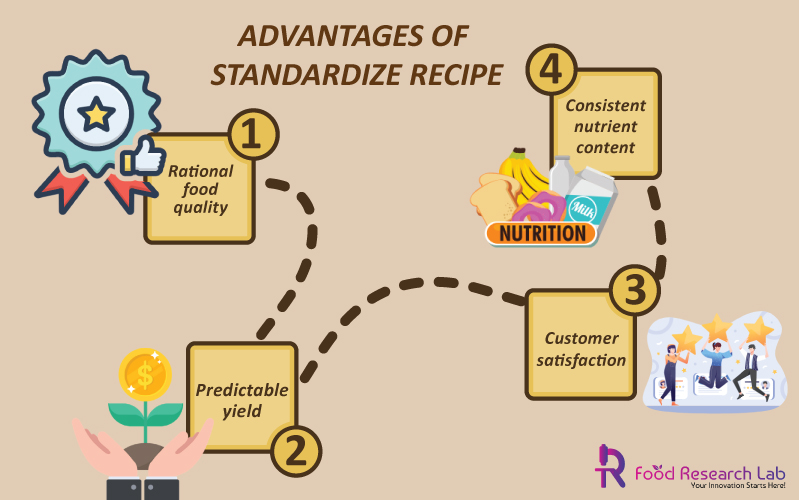
Describe the Information Included in standardized recipe writing for masala soups
Brief:
- Nowadays, local food culture, consumption of traditional food ingredients such as native groceries, vegetables have lost their actual value.India is one among the nations with oldest and varied cuisines, cooking patterns and components oriented towards medicinal and nutritious fact.
- Standardized recipes can help representatives toproduce menu items most efficiently if they also list professional kitchenplace for small operator needed for the recipe, such as measuring tools, preparation tools, holding pans, cooking utensils.
- Food research lab offers help to new food product development which increased quality of food, taste. Experts help in our consultation assistin writing the standardized recipes, accuracy, measurements and number of serving.
Introduction:
All recipes are not cooked equally. Some recipes have missing factors, fault spices,incomplete or inadequate instructions, causing more work, and some are not approved.A standardized recipe is a set of carrying information used toprepare a known quantity and quality of food for an individual region. A standardized recipe producesa product that is ofsame taste every time it is made, no material which follows the directions. There are some food consulting services with experts help to make a better product than others.
An excellent standardized recipe will consist of:
- Menu item name – the name of the given recipe that should be logical with the name on the menu
- Total Yield – number of plates, or servings that a recipe production, and often the total weight or amount of the recipe
- Portion size –quantity or size of the individual portion
- Ingredient list, the exact capacity of each ingredient (many food innovation companiesexcept for masalas that may be added to taste)
- Preparation procedures – Specific guidelines for the order of effort and types of operations (e.g., blend, fold, mix, sauté and some new product development in food industries)
- Cooking temperatures and times, demanding control points and limits to ensure the dish is cooked correctly and carefully
- Particularinstructions, according to the standard format used in an application
- The professional kitchenshould include a list of equipment and individual ingredient preparation methods.
Benefits of using a standardized recipe include:
- Yieldquality and quantity product
- Known standard serving size and cost
- Assuring nutritional capacity and addressing dietary regards such as special diets or food allergies
- Helping secure compliance with “Truth in Menu” conditions
- Promote in forecasting and some food consultancies
- Evade slight errors while doing food orders
MainIdea
Soups provide both flavour and nutrition. Once you understand the needed procedures to considerforpreparingsoups, youcancreateavarietyofclassicand creativesoups recipes.
Standardized masala soup:
Choose a type of fat
If your soup is high in fibre, it will help you add bulks to your meal and help you feel full. Your soup possibly needs to begin with some healthy fat, like butter or olive oil. This is to fry any root vegetables or other primaryextract.
Determine your ingridients:
Rock salt and pepper are your two most basicspices, andthere is a need to include them in your recipe. Here is a few higher popular flavours consolidation.
- Parsley seed, marjoram, thyme, parsley, and sage go well with soups.
- Marjoram, rosemary and thyme go well with spicy soups
- Basil, oregano or fennel can bean excellent addition to tomato-based soups
- Chilis need chilli powder and cumin.

Applying to standardize recipes provides many advantages like:
- Rational food quality: The benefit of standardized recipes provide that menu items will be reasonablein quality each time they are planned and served.
- Predictable yield: The prepared number of servings will be formed by using standardized recipes. This can help to lower the amount of leftover food if there is overproduction, and also will help to avoid shortages of servings on the line. An absoluteyield is especially important when food is transferred from a produced kitchen to other serving sites.
- Customer satisfaction: Well-developed recipes that demand to students are an essential element in cultivating and increasing student cooperation levels. Schools may take a practice from restaurant chains that have advance popular menu items rational in every detail of factors, quantity, formulation, and proposal. Standardized recipes provide this flexibility and can result in increased customer satisfaction.
- Consistent nutrient content: Standardized recipes will establish that nutritional values per serving are valid and logical.
Conclusion:
The slightalternation that has to be made when modifying a recipe can only be accomplished from involvement, as there are no hard and fast rules. Generally, if you have recipes that you often use, convert them, test them, and then keep a transcript of the recipes regulate for different yields. Our consultancy helps to provide various services like research and planning, concept development, recipe development, menu developments to give the consumer a better product.
References:
- Dixit AA, Azar KMJ, Gardner CD, Palaniappan LP. Incorporation of Whole, Ancient Grains into a Modern Asian Indian Diet: Practical Strategies to Reduce the Burden of Chronic Disease. Nutrition reviews. 2011;69(8):479-488. doi:10.1111/j.1753-4887.2011.00411.x.
- Hee Sun Jeong& Yoon-Joo Kang. Journal of The Korean SocietyofFoodCulture.
- Blair, Eulalia, “How to Write Cost Controls into Your Recipes,” Institutional Feeding and Housing, January 1959, pp. 42-47.
- Callahan, James F., “New Method of Calculating Yield of Recipes,” Journal of the American Dietetic Association, January 1959, pp. 45-47.






